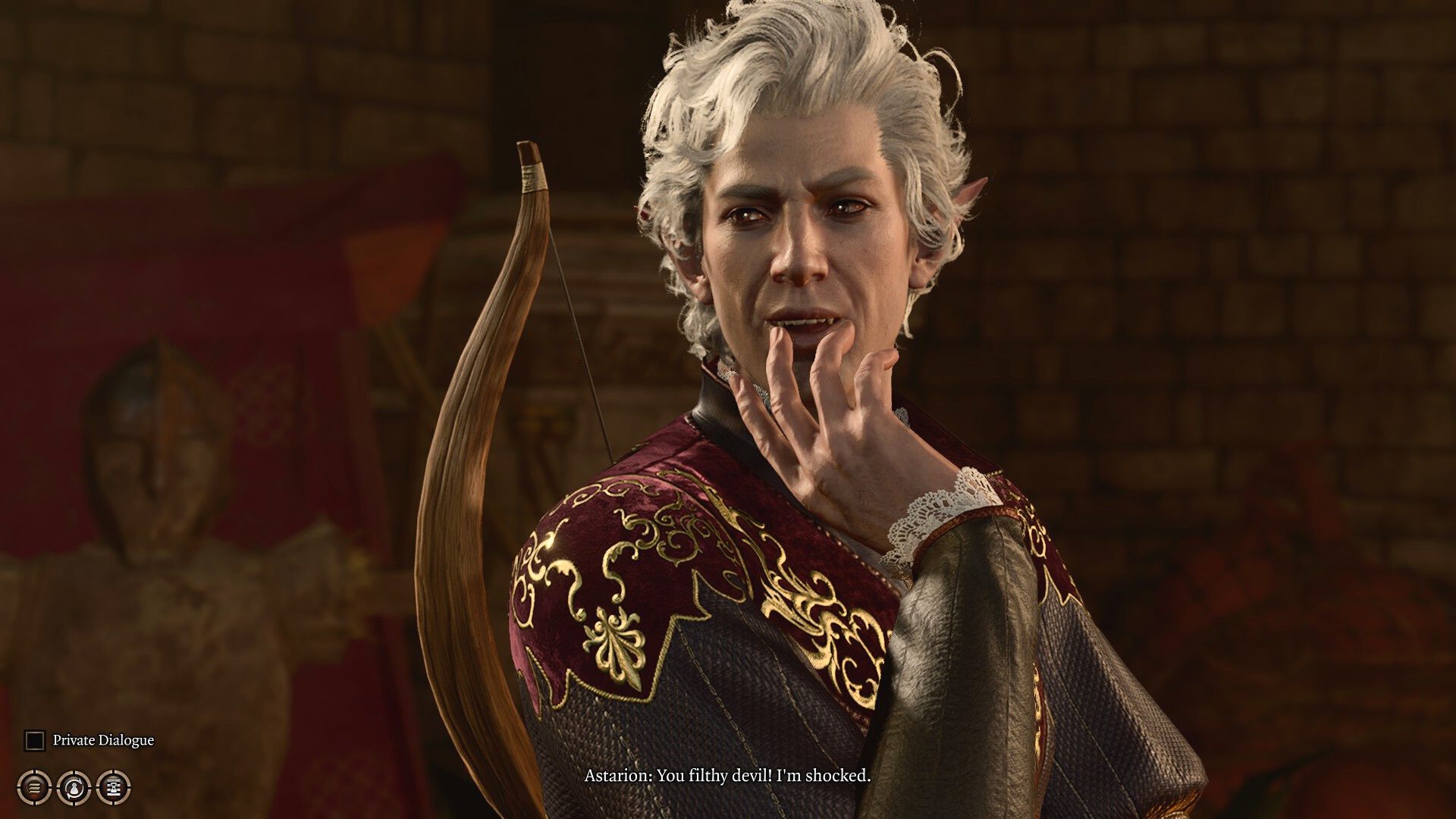Intimate ‘Baldur’s Gate 3’ Moments Spark Conversations Among Couples—By Design
Thog does care.

Over the weekend, the Dungeons & Dragons YouTube channel released an extensive interview with Baldur’s Gate 3 director and Larian Studios CEO Swen Vincke. The conversation ranged from technical hurdles in production to player creativity. However, one of my favorite parts was when Vincke talked about how this game could prompt conversations among couples—especially the romancing mechanic. It’s fascinating to hear Vincke discuss something myself and other players have experienced in our relationships. (After showing my partner Girlfriend Review’s take on playing with her boyfriend, I got so many glares.)
Interviewer and Legends of the Multiverse showrunner Todd Kenreck asked Vincke about his referral to the split-screen co-op as “couples mode.” While split-screen co-op is available for PC players, this feature is a beloved attribute of console games. After all, for many people, their first memory of playing console games involved a communal setting—like a friend’s living room or crammed into a bedroom. This question from Kenreck came on the eve of September 6, the day BG3 was released on PS5. (They’re still working on the Xbox release.) Vincke shared that these co-op moments were very important to him because he loves playing with his wife.
Romancing in BG3 with your significant other
This experience isn’t exclusive to Vincke, as a lot of gamers have expressed similar enjoyment. Between his role as both BG3‘s director and Larian’s CEO, he could just make it happen. Vincke started by waxing adorably about his love for his wife and their moments gaming together:
Some of our fondest memories was playing World of Warcraft sitting next to one another [while] she was pregnant. My son grew up to be in an incredible gamer as a result of that. There were games, like Dark Alliance, back in the days that you could play in split-screen. Those were really special because it’s on the singular screen—you know when they were [in the] living room. Setting up on the PC is different than lying in your couch, so I always enjoyed those split-screen moments.
Vincke stated he wanted to bring this experience to a role-playing game that was narratively driven. Outside of the occasional game like It Takes Two and Divinity: Original Sin 2 (another Larian Studios title), most split-screen co-op games are story-light and/or first-person shooters. There’s a lack of these types of games as the years go by. Studios find it more profitable to require buying two-plus copies of a game rather than a shared split-screen experience. Vincke continued:
Here with BG3 now you got romance in the game. So, you get this incredible experience where you’re sitting with your partner and you’re romancing somebody in the game. It leads to really interesting emotionally engaging moments right?! I love it. It’s great, right, because couples are different. So, it’s typically like, ‘really … going to do that?!’ [and then a] ‘of course I’m going to do it! What you expect me to do?’ That’s unique and so it creates even more engagement in the relationship.
Vincke ended this answer by once again praising the work of the BG3 team for configuring this complicated system—especially with the very limited real estate of a split-screen. While Vincke talked about these moments with his partner in the context of split-screen co-op, I can confirm this happens in other forms of play.
Lae’zel, and Astarion, and Halsin—oh, my!
The first sex scene I saw in the game uncensored (thanks, YouTube) actually involved my partner’s solo-game character, Dorito. After Lae’zel made an advance towards the Half-Elf ranger, he Facetime’d me to let me know what was about to happen. I literally ran to his office. After convincing him to select the dialogue that pushed against Lae’zel’s nature to dominate Dorito—y’all, we were both blushing. Unfortunately, this excitement didn’t extend outside the game in every respect. I was told not call a video game character “our girl” while running errands two weeks later. (Boo!)
In another run, a similar experience happened with very different results. Here, I’m playing Ellesméra (a Zariel Tiefling bard) alongside TMS writer Madeline Carpou‘s Olive (a Gloom Stalker Half-Orc ranger), and my partner’s Thog (a Wildheart Half-Orc barbarian). As in my solo run, Lae’zel found my character an irresistible companion. Haters don’t understand that she just has a direct way of expressing herself! Anyway, when Lae’zel finally approached my character for some nude midnight sparring, this was viewable for everyone in my party. I even got a notification that Olive and Thog were “listening in.” (And I could block them by clicking “Private Dialogue,” though I didn’t.) Dorito may have dommed, but Ellesméra allowed herself to submit to the Githyanki warrior.
On the complete opposite end of the spectrum, and during an earlier play session, we watched everyone but Olive get rejected. This was at the Tiefling party in Act 1, of course. I’ve not recovered from watching Karlach friendzone Thog only to then get the “it’s not me, it’s you … I have standards” treatment from a last-ditch effort to hook up with Astarion—a character he doesn’t even like! This is not the worst Astarion rejection I’ve seen, but it was at the time.
My partner and I bitterly bonded over every single character declining us on that celebratory evening. (Later, dialogue revealed that Astarion and Lae’zel hooked up.) Meanwhile, Madeline got her umpteenth first night with Shadowheart. While not as salacious, it’s still intimate and interesting to share instead of watching it alone. It may sound like I’m kissing and telling, but that couldn’t be further from the truth. Regarding relationships and encounters alone, I didn’t even get into Astarion, Halsin, and more. What’s not already on TMS stays between my party (and in my screenshots folder).
To see more of this interview check it out here:
(via Dungeon & Dragons on YouTube, featured image: Larian Studios)
Have a tip we should know? tips@themarysue.com